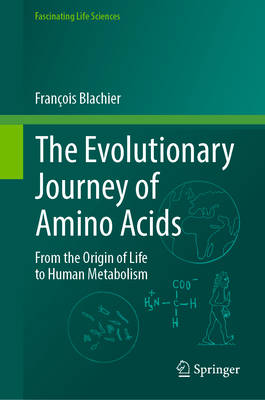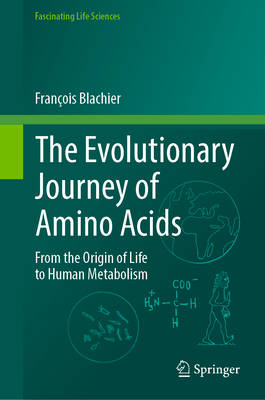
- Afhalen na 1 uur in een winkel met voorraad
- Gratis thuislevering in België vanaf € 30
- Ruim aanbod met 7 miljoen producten
- Afhalen na 1 uur in een winkel met voorraad
- Gratis thuislevering in België vanaf € 30
- Ruim aanbod met 7 miljoen producten
Zoeken
The Evolutionary Journey of Amino Acids
From the Origin of Life to Human Metabolism
François Blachier
€ 167,95
+ 335 punten
Omschrijving
This book takes readers on a journey from the very fundamental and chemical beginnings of amino acids on Earth to their role in human metabolism. It provides background on how amino acid metabolism has changed across the evolutionary tree and discusses their physico-chemical properties as well as their biochemical roles across various forms of life. Amino acids are emerging as key players in numerous physiological functions and are being increasingly recognized as playing a mechanistic role for the communication between the gut microbiota and the host in healthy state and in some pathophysiological situations. However, understanding these associations requires a multidisciplinary approach, combining chemistry, biochemistry, physiology, nutrition, molecular/cellular biology and microbiology. This book aims to describe the science behind amino acids from their first appearance and evolutionary significance, all the way through the tree of life to humans, and then to consider how gut microbial amino acid metabolism regulates human physiology and risk in some chronic diseases. It covers key concepts such as the characteristics of different amino acids found in living organisms, their existence in the pre-living world, and their vital roles in metabolism and physiology. It also explores intriguing questions about microbial communication and the effect of amino acid-derived microbial metabolites on mammalian cells. With this multidisciplinary approach and accessible structure, this book will appeal not only to students and researchers with a background in biochemistry and related fields, but also to non-specialists with an interest in the foundations of life at the intersection of evolutionary biology and metabolism.
Specificaties
Betrokkenen
- Auteur(s):
- Uitgeverij:
Inhoud
- Aantal bladzijden:
- 241
- Taal:
- Engels
- Reeks:
Eigenschappen
- Productcode (EAN):
- 9783031933929
- Verschijningsdatum:
- 25/06/2025
- Uitvoering:
- Hardcover
- Formaat:
- Genaaid
- Afmetingen:
- 165 mm x 237 mm
- Gewicht:
- 594 g

Alleen bij Standaard Boekhandel
+ 335 punten op je klantenkaart van Standaard Boekhandel
Beoordelingen
We publiceren alleen reviews die voldoen aan de voorwaarden voor reviews. Bekijk onze voorwaarden voor reviews.








